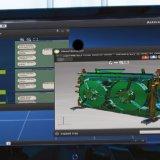
Siemens PLM Software, a business unit of the Siemens Industry Automation Division and a leading global provider of product lifecycle management (PLM) software and services, has announced a new version of Teamcenter software, a widely used PLM system. Teamcenter 9 delivers new solutions and enhancements across the portfolio in support of Siemens PLM Softwares HD-PLM vision, which was established to help companies make better informed decisions more efficiently and with a higher level of confidence.
Teamcenter helps companies deliver increasingly complex products while maximizing productivity and streamlining global operations. The Teamcenter 9 release adds a new integrated systems engineering solution and tightens the integration across the unified architecture so companies can make smarter decisions with better visibility into the impact of those decisions. Enhancements across the entire Teamcenter portfolio significantly improve productivity so companies can get to market faster, while reducing total cost of ownership.
To face the challenge of increasing globalization of the enterprise and the ever-growing complexity of products, our customers require a more intelligent PLM system that provides the right information to the right person at the right time, said Eric Sterling, Senior Vice President, General Manager, Lifecycle Collaboration Software, Siemens PLM Software. Teamcenter 9 continues to build on the unified architecture with a more integrated approach to connecting the information generated by teams across the extended enterprise, while giving them a more personalized and productive user experience.
Systems Engineering
The new Teamcenter systems engineering solution provides a fully-integrated approach to systems engineering and requirements management. Unlike traditional systems engineering solutions that use stand-alone tools for system modeling, documenting interfaces, and documenting requirements, Teamcenter delivers a more systems-driven approach to product development that is managed from within the Teamcenter environment. This enables a common view of the system up and down the value chain, helping to eliminate costly late-stage system integration problems that result from requirements not being tied to physical implementation. Teamcenter 9 accelerates the product development process through intelligently integrated information, and ensures all departments and disciplines are using synchronized product information.
In addition, integrations with familiar best-in-class tools like Microsofts Outlook messaging software, Word, Excel spreadsheet software, and Visio software, as well as MathWorks MATLAB environment and Simulink environment, support a variety of methodologies for systems definition and modeling using the tools that engineers are used to using.
Content Management
Technical documentation is a critical component of product development as it supports the delivery of documents such as user guides and repair manuals along with the release of a product. In the past, product development needed to be completed before documentation could be created due to the ever-changing nature of design.
The enhanced integration of content management in Teamcenter 9 allows product documentation to be created in parallel with the design process. This ensures that changes are communicated as they occur and their impact can drive documentation more efficiently. Moreover, because todays products often have multiple options and variations, Teamcenter content management supports configuration-driven documentation that reuses common components of text, graphics and meta-data. This provides efficient, context-based multi-channel publishing to support the need for multi-media delivery on different devices and in multiple languages to support global markets.
In addition, an even tighter integration to Cortona3Ds Rapid Author application enables documents to be created with illustrations that remain linked to the design data they describe so changes can ripple all the way through to the documentation. The new release also supports the latest version of the S1000D standard used in aerospace and government documentation as well as the DITA (Darwin Information Typing Architecture).
Service Lifecycle Management
Siemens PLM Software extends its Service Lifecycle Management vision with a new service scheduling and execution module. Service scheduling and execution have traditionally been separate activities conducted outside of PLM. This has made it difficult to track whether service has been completed in compliance with published procedures, which increases safety risks, product failures, or even downtime that could result in additional costs or fines.

 In
In
Add new comment